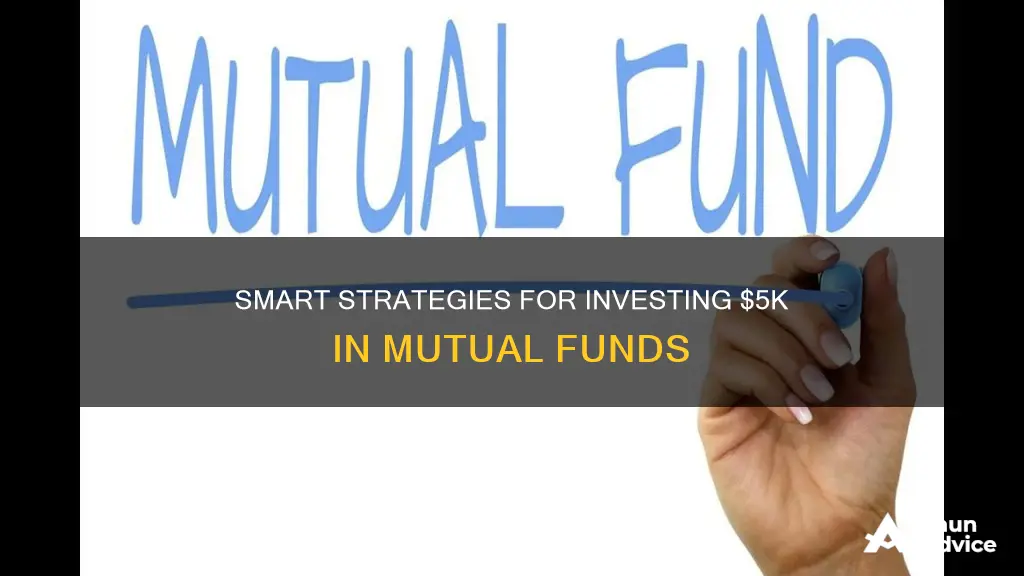
Investing $5,000 can be a great way to make your money work for you. Before you start investing, it's important to ensure your finances are in good shape. This includes paying down any high-interest debt and creating an emergency fund of three to six months' worth of expenses. When it comes to investing, there are several options to consider, each with its own level of risk and potential return. These include investing in real estate, stocks, mutual funds or exchange-traded funds (ETFs), bonds, or using robo-advisors. It's also important to choose the right investment account, such as a 401(k), IRA, or 529 plan, to maximize tax advantages. Diversification is key to reducing risk, and investing in an S&P 500 index fund is a popular way to gain exposure to a broad range of companies. Ultimately, the best investment strategy depends on your financial goals, time horizon, and risk tolerance.
What You'll Learn

Invest in your 401(k)
Investing in your 401(k) is a great way to grow your money. Here are some tips to help you maximize your 401(k) investments:
- Start contributing early: The power of compounding returns means that the earlier you start investing in your 401(k), the more time your money has to grow. Even if you can't contribute a large amount, starting early will help build a secure retirement nest egg.
- Maximize employer matching contributions: Many employers offer to match your 401(k) contributions up to a certain percentage. Take advantage of this by contributing at least enough to get the full match. It's essentially free money that can boost your retirement savings.
- Understand your risk tolerance: Before deciding how much to save and how to allocate your 401(k) investments, assess your risk tolerance. Consider your age, investment options, and comfort with market risk to determine an allocation strategy that aligns with your goals and risk tolerance.
- Diversify your 401(k) portfolio: Diversification helps reduce risk. Consider a mix of stocks, mutual funds, bonds, and other investments based on your age and risk tolerance. The "100 minus age" rule is a common guideline, suggesting the percentage of stocks in your portfolio should be 100 minus your age.
- Rebalance your portfolio periodically: As different assets fluctuate in value, periodically rebalance your portfolio to maintain your desired allocation. This may involve buying or selling assets to get back to your target allocation.
- Increase your savings rate over time: As your income increases, try to contribute more to your 401(k). Aim to increase your savings rate with each raise or bonus to maximize your retirement savings.
- Avoid premature withdrawals: Early withdrawals from your 401(k) can incur penalties and taxes. It's best to leave your money in the account to grow until retirement, if possible. If you need to access your funds, understand the rules and potential consequences first.
Single Investment Strategies to Fund Your Future
You may want to see also

Use a robo-advisor
Robo-advisors are digital platforms that provide automated, algorithm-driven financial planning and investment services with little to no human supervision. They are a low-cost alternative to traditional financial advisors, charging annual flat fees of less than 0.4% per specific amount managed, compared to the typical 1% charged by a human financial planner.
Robo-advisors are best suited for those with a small account and limited investment experience. They are efficient, accessible, and available to retail investors, requiring low opening balances. They are also convenient, as you can log in 24/7 as long as you have an internet connection.
Robo-advisors like Wealthfront and Betterment have a low required minimum investment amount of $500 and $10, respectively. They offer a range of features, including tax-loss harvesting, high-yield cash accounts, and portfolio management.
Robo-advisors are not ideal for those who require services like estate planning, complicated tax management, trust fund administration, and retirement planning. They also lack human interaction and have limited investment opportunities.
Schwab S&P 500 Index Fund: A Smart Investment Choice
You may want to see also

Open an IRA
Opening an individual retirement account (IRA) is a great way to invest $5,000. IRAs are important tools that help you save and invest for retirement. Unlike 401(k)s, which are largely accessed through workplace programs, IRAs are open to virtually anyone.
Here's a step-by-step guide on how to open an IRA:
- Decide between an online broker or a robo-advisor: This depends on your investment style. If you want to choose and manage your investments, go for an online broker. If you prefer an automated way to manage your investments, choose a robo-advisor. Robo-advisors will select low-cost funds and rebalance your portfolio for a fraction of the cost of hiring a human financial advisor.
- Choose where to open your IRA: If you're a hands-off investor, look for a robo-advisor with a low management fee and services that meet your needs. If you're a hands-on investor, opt for an online broker with low or no account fees, small commissions, a wide selection of no-transaction-fee mutual funds, and solid customer support.
- Open your IRA account: Visit the provider's website and choose the type of IRA you want to open (Roth or traditional). Provide personal details such as your Social Security number, date of birth, contact information, and employment information.
- Fund your account and get started: You can fund your IRA by transferring money from a bank account, moving existing IRA assets from another firm, or rolling over a 401(k). The annual contribution limit for IRAs is $7,000 in 2024 ($8,000 if you're 50 or older), but you don't have to contribute the maximum amount. Starting early with any amount is better than nothing.
When choosing an IRA provider, consider factors like investment selection, retirement planning tools, customer service, and educational resources. Some recommended IRA providers for hands-on investors include Robinhood, Charles Schwab, Interactive Brokers, and Fidelity. For hands-off investors, Betterment, Vanguard Digital Advisor, and SoFi Automated Investing are good options.
Remember, when it comes to retirement, starting early and investing regularly are key to growing your savings over time.
Mutual Funds 101: Best Places to Invest for Beginners
You may want to see also

Buy commission-free ETFs
Exchange-traded funds (ETFs) are a great way to invest $5,000. ETFs are similar to mutual funds in that they are a mix of stocks, bonds, and other investments, but they can be bought and traded like stocks.
ETFs are a more accessible investment than your retirement account, and they are generally more stable, diverse, and safe than individual stocks. They are also more affordable than mutual funds because they track a blend of investments, meaning there are fewer trades and lower costs.
When buying ETFs, you will want to focus on commission-free ETFs so you are not paying a fee each time you buy or sell. While rare these days, those fees can run up to $10 and drag down a small investment. Most brokers offer a list of commission-free ETFs.
- Qtrade Direct Investing offers 100+ commission-free ETFs, allowing you to build a well-diversified portfolio.
- Vanguard and Schwab are two big-name companies that offer commission-free ETFs.
- IShares also offers a number of reputable commission-free ETF options.
Pension Investment Funds: Choosing the Right Option for You
You may want to see also

Pay down debt
If you have existing debt with a high interest rate (above 9%), it's best to pay that down before investing. Any interest that high can easily cancel out what you earn from investments.
- Transfer your credit card balances to a single loan or card with lower rates. This can save you money on interest and help you pay off debt faster.
- Take out a credit card refinancing loan. These loans often come with lower interest rates than credit cards, and you'll only have to keep track of one payment.
- If you can't afford to pay more than the minimum, consider a balance transfer card with a 0% APR introductory period. This will allow you to pay off your debt interest-free, but you'll need good or excellent credit to qualify.
- If you have multiple credit cards, focus on paying off the smallest debts first. This will keep you motivated as you move on to larger debts.
- If you have multiple credit cards, another option is to pay off the debts with the highest interest rates first. This will save you a lot of money, but it can be discouraging because it's a slow process.
Even if you can only make minimum payments on your debt, it's important to start paying it off as soon as possible. The longer you wait, the more money you'll end up spending on interest.
Mutual Fund Investment Guide for NRIs in India
You may want to see also
Frequently asked questions
If you're looking for low-risk investments, consider investing in government or municipal bonds, which are typically seen as less risky than stocks. You could also look into opening a savings account or a certificate of deposit (CD), which offer steady, low-risk returns.
When choosing an investment account, consider tax-advantaged accounts like 401(k)s, IRAs, or 529 plans, which offer tax breaks and allow your investments to grow tax-free. These accounts are a great way to minimize taxes and maximize returns.
Before investing, assess your goals and time horizon, as well as your risk tolerance and financial circumstances. If you need the money within a short time frame, investing heavily in stocks may not be the best option due to their volatile nature.
Mutual funds allow you to invest in a diversified portfolio of stocks or other assets by pooling your money with other investors. This helps reduce risk and provides access to a wider range of investments. Mutual funds are typically purchased directly from mutual fund companies or through brokerages.
If you're looking for alternatives to mutual funds, consider exchange-traded funds (ETFs), which are baskets of equities traded on stock exchanges. ETFs offer diversification and access to a variety of investments, including stocks, bonds, and real estate. Robo-advisors are another option, providing personalized investment portfolios based on your risk tolerance and goals.







